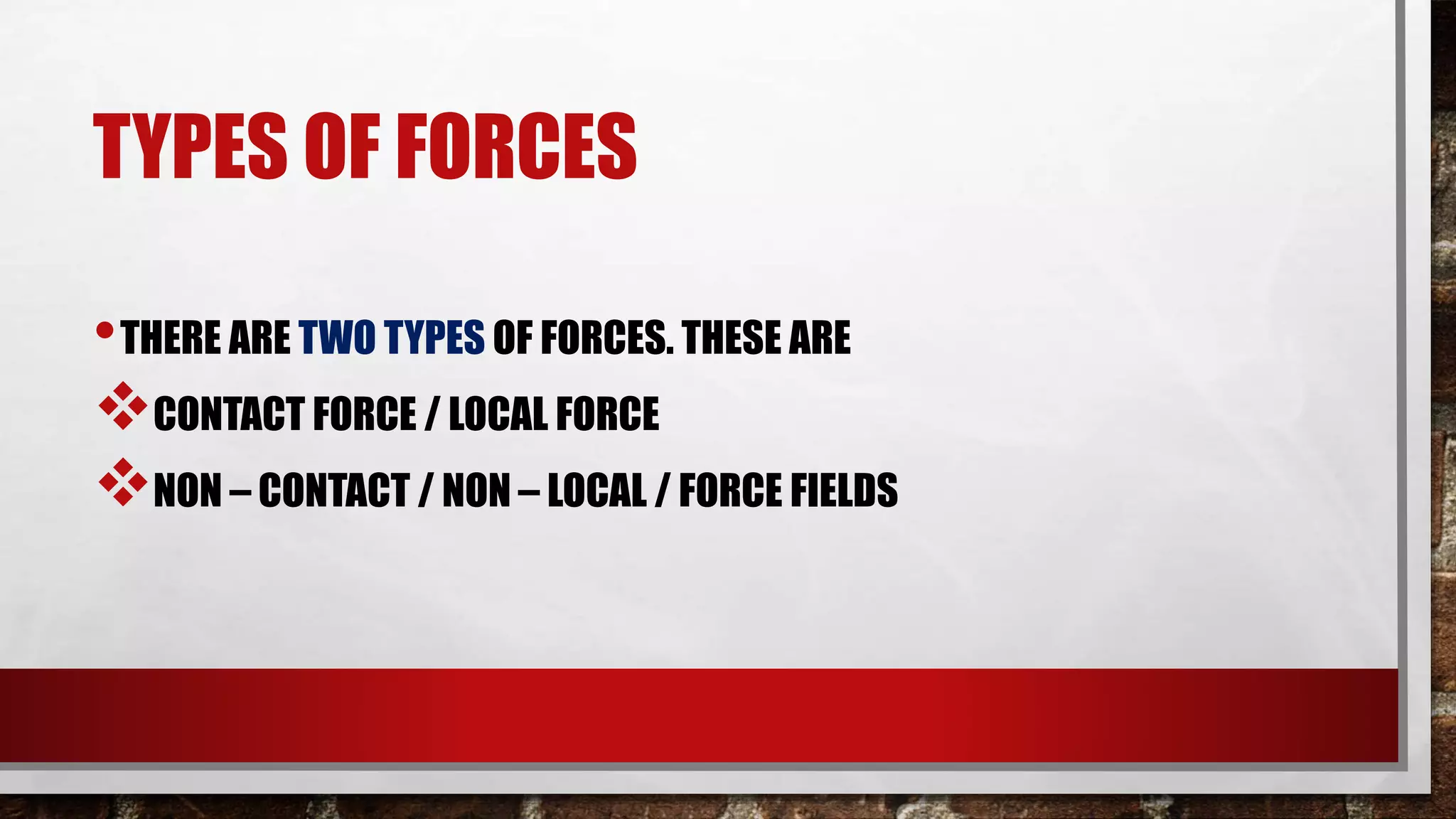The document discusses different types of forces including contact forces, non-contact forces, frictional forces, and buoyant forces. It defines force as a push or pull that can change the motion of an object. There are two main types of forces - contact forces that act directly between objects in contact, and non-contact forces that act over a distance through force fields. Examples of both types are given. Frictional forces oppose the relative motion of objects in contact and can be useful or disadvantageous depending on the situation. The coefficient of friction and methods for measuring it are also described.






















![Question
A 200 kg body rest on a surface inclined 25 ° to the horizontal. If this body
is pulled down along the plane with a force of 100 N. Calculate
i. 𝐹𝑥 force ii. Total force in the direction of motion iii. The
resultant force iii. The acceleration of the body act along the plane
[Take 𝜇 𝑎𝑠 0.3]](https://image.slidesharecdn.com/forces-200302082731/75/Forces-Frictional-force-23-2048.jpg)




























![BODIES ON INCLINED PLANES
𝑓𝑥 = 𝜇𝑅 = 𝜇𝑚2 𝑔 𝑐𝑜𝑠𝜃
For 𝒎 𝟏
𝑚1 𝑎 = 𝑚1 𝑔 − 𝑇 − (1)
For 𝒎 𝟐
𝑚2 𝑎 = 𝑇 − [𝑓𝑥 + 𝑚2 𝑔 sin 𝜃 ]
Eqn (1) + eqn(2)
𝑚1 𝑎 + 𝑚2 𝑎 = 𝑚1 𝑔 − (𝑓𝑥 + 𝑚2 𝑔𝑠𝑖𝑛 𝜃)
𝑎 𝑚1 + 𝑚2 = 𝑚1 𝑔 − (𝑓𝑥 + 𝑚2 𝑔𝑠𝑖𝑛 𝜃)
𝒂 =
𝒎 𝟏 𝒈
𝒎 𝟏 + 𝒎 𝟐
−
(𝒇 𝒙 + 𝒎 𝟐 𝒈𝒔𝒊𝒏 𝜽)
𝒎 𝟏 + 𝒎 𝟐](https://image.slidesharecdn.com/forces-200302082731/75/Forces-Frictional-force-52-2048.jpg)
![BODIES ON INCLINED PLANES
𝑓𝑥 = 𝜇𝑅 = 0.2 × 2 × 10 cos 30 = 3.5
For 𝒎 𝟏
𝑚1 𝑎 = 𝑚1 𝑔 − 𝑇
𝟏𝟎𝒂 = 𝟏𝟎𝟎 – 𝑻 __ (𝟏)
For 𝒎 𝟐
𝑚2 𝑎 = 𝑇 − [𝑓𝑥 + 𝑚2 𝑔 sin 𝜃 ]
2𝒂 = 𝑻 – (𝟑. 𝟓 + 𝟐 × 𝟏𝟎𝒔𝒊𝒏 𝟑𝟎
2𝒂 = 𝑻 − 𝟏𝟑. 𝟓 __ (𝟐)
Eqn (1) + eqn(2)
12𝑎 = 100 − 13.5
𝒂 = 𝟕. 𝟐𝟏𝒎/𝒔 𝟐
Substituting a = 7.21 into eqn 1
𝟏𝟎 𝟕. 𝟐𝟏 = 𝟏𝟎𝟎 − 𝑻
𝑻 = 𝟐𝟕. 𝟗
= 10 kg
𝟑𝟎°
= 2 kg
𝝁 = 𝟎. 𝟐](https://image.slidesharecdn.com/forces-200302082731/75/Forces-Frictional-force-53-2048.jpg)

